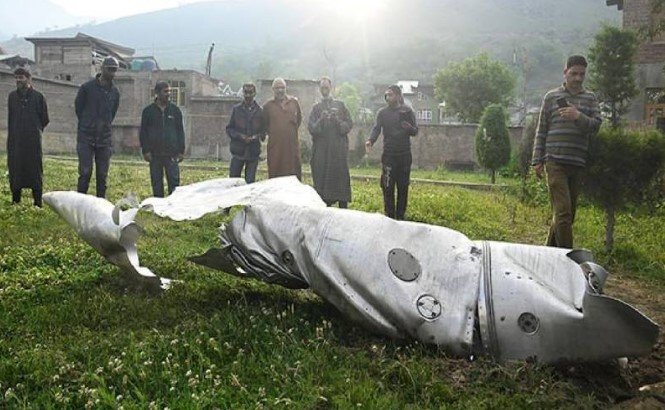As Southeast Asia’s nuclear-armed foes sharpened their rivalry on Tuesday, it was reported that a missile strike by India killed 8 Pakistan civilians in the border crossfire. Subsequently, Pakistan reported downing five Indian fighter planes.
Islamabad/New Delhi – India and Pakistan have been in an ongoing subtle conflict; however, on Tuesday, India was reported to have used missiles to attack deeper into Pakistani territory, claiming the lives of eight civilians, alongside two children. As retaliation, Pakistan has claimed its jets shot down five Indian Air Force aircraft.
The recent confrontation has raised alarm bells about the possibility of escalated military conflict between the two countries, which hold volatile relations and nuclear weapons, especially concerning the Kashmir area.
Indian troops fired a BrahMos-type air-to-ground missile that struck at the
western suburb of Kotli in the Azad Kashmir region of Pakistan, around 3:30 am local time, as reported by the Pakistani army.
“Eight innocents’ lives have been taken during an unprovoked missile strike by India,” remarked Major General Ahmed Sharif Chaudhry, spokesperson for Pakistan’s Inter Services Public Relations (ISPR). “This is an aggressive act and a breach of international law.”
Affected people are reported to be from the same household. Local media have published videos showing the debris of houses that were smashed to the ground, broken pipes, and emergency responders removing corpses from the debris.
Civilians who are in critical condition are being airlifted to Rawalpindi for proper medical care, placing hospitals in the surrounding area on standby.

Pakistan Said They Shot Down Five Indian Planes
The Pakistan Air Force (PAF) claims it engaged with several Indian fighter jets that crossed the Pakistani border over the LoC a few hours after the missile attack. This responded drama-staged military advance.
Faheem Siddiqui, a PAF Air Vice Marshal, declared in a publicly broadcasted remark, “Five Indian fighter jet aircraft; two Sukhoi Su-30MKI, two Mirage 2000, and one MiG-29 were intercepted and eliminated,” during the PAF’s expresses recalling, “Our air defense systems reacted perfectly while holding full accountability.”
According to Pakistan, the jets had gone rogue and tried executing strike and verification missions; however, they were destroyed before achieving any vital objectives.
The government of Pakistan issued a press release with purported evidence of the aircraft being struck, which included radar tracking footage as well as poor-quality infrared pictures. None of this information has been verified.
Pakistan Provokes: India Responds with Denial and Propaganda Accusations
The Ministry of Defence of India wasted no time in issuing a statement where they denied striking civilians and labeled Pakistani representatives ‘liars’ for suggesting that aggressive action has been taken that results in raising hostilities between Pakistan and India.
The Indian statement later noted, “No deliberate airstrike has been made aimed at cross-border civilian targets. Any missile activity conducted was strictly in response to cross-border shelling and militant infiltration supported by elements from Pakistani soil.”
India did, however, acknowledge operations conducted in proximity to the LoC but within Indian territory, on the grounds of necessary national security measures. Such actions were branded as dealing with active militant threats.
As for the weapons claiming five jets have been shot down, officials from the Indian Air Force dismissed such falsified claims, affirming that all Indian jets have securely returned to base.
‘‘No Indian fighter jet has been lost. Pakistan’s claims are entirely fabricated. As such, no Pakistani aircraft have ever been downed either,” said Indian Air Marshal Vivek Chaudhari. “It is regrettable, and we still request moderation and inhibit Pakistan from indulging in mass hysteria.”
The US and Other Global Powers Call For Restraint
The United Nations also seems to be the more concerned parties and has called on both to retreat from escalating the issue further into full-blown conflict.
“We call for a Working Group to be established with no delay and for the Parties to suspend all armed actions of violence,” said spokesperson UN Secretary-General António Guterres, Stéphane Dujarric. “In no conflict, any party must not strike civilians”.
So did the United States, China, and the UK make a similar appeal. The United States said it was communicating with both parties on these conflicting issues and urged Iran to avoid openly looking into the internal matters.
Matthew Miller restores order, calling, “Both Parties control all actions that lead to further violence, and these are useless actions that lead to loss of civilians”.
Kashmir: The Hot Spot Twilight Zone Again
This region under the control of Indian Pakistan conflict is the border that, no matter which part is drawn, divides two territories, it has been the center point of many wars since 1947 AD.”
Although a ceasefire was agreed upon in 2003 and reestablished in 2021, recent months have seen escalated tensions, particularly after an increase in militant activities along the Line of Control (LoC) and ongoing political chaos within the region.
It is the position of Indian authorities that Pakistan continues to shelter and support militant organizations operating in the Indian-held region of Kashmir. Pakistan denies these allegations, relocating the rhetoric to state that it offers only moral and diplomatic support to the people of Kashmir wanting to determine their political status.
The events of Tuesday have once again reignited fears of large-scale confrontation, more so when both nations are heavily militarized along the border.
International observers have expressed alarm.
Defense analysts and experts in conflict resolution consider the latest episode one of the most serious in what is known as the Balakot strikes escalations of 2019, where both countries claimed to have bombed designated areas and brought down fighter jets in retaliation.
“This has the potential to be disastrous. War could break out as a response to errors of judgment or aggressive acts stemming from political miscalculations,” said Dr. Farah Qureshi, a London-based expert on international conflicts.
“The need to carry out peace talks even if discreetly is fundamental for both governments at this very moment,” was her closing statement.
While lacking immediate action, international pressure is said to be impossible to avoid. Foremost, steering political agendas for leaders on both sides due to the increasing nationalistic support exhibited from both countries makes it improbable to offer dialogue anytime soon.
Back home in India, the most domestically hawkish elements are creating electoral pressure on the Modi government to adopt a hard stance. Simultaneously, the military continues to be a dominant power in Pakistan, where social and political fury is escalating in demand to respond fierce.
Table of Contents
What’s Next?
Although formally declaring war has not been an option for either side yet, skirmishing activity along the LoC is growing, having been recently reported troop reinforcements, jet flyovers, and blackout drills in bordering towns.
According to military sources, India has put its military standing on DEFCON 3, while Pakistan positioned its strategic forces on “high readiness.” _“Low intensity conflict”_ and _“Hybrid warfare”_ are among the diplomatic measures enabled between the two nations.
The risk within the next few days will be where the scale shifts, depending on will the situation will be stabilized through diplomatic efforts or take a swift turn towards escalation.



